Ousmane Sembène’s Xala ((1975) opens with an abstract retelling of the fight for Senegalese independence. The brave men march into the all-white Chamber of Commerce, kick them out, and stand victorious before a crowd. What next, then? The Chamber of Commerce building still stands as a monument to the colonization of Senegal. Should it continue to stand? In the eyes of these men, the “liberators” of Senegal, the answer is yes. The men, in fact, walk back inside to form the new Chamber. They become the men in dark suits who accept bribes from the French to assert the status quo. And they become a colonized elite class that accumulates just enough to think it is powerful.
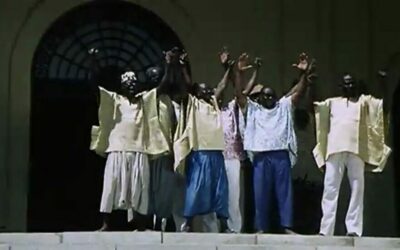
It is with this opening sequence, the birth of the colonized elite, that Sembène sets the stage for Xala, which tells a story of such elite’s fragility. Adapted from, or perhaps made in tandem with, Sembène’s own novel of the same name, Xala centers El Hadji Abdoukader Beye (Thierno Leye), a powerful Senegalese businessman who is struck with impotence on the night of his marriage to his third wife. His quest to heal his impotence leads him on a journey that shows that his power derives only from the neo-colonial systems he upholds. Hadji thinks of himself as the master of his life and his world. But he is master of nothing.

The new Chamber thinks very highly of itself in having “decolonized” Senegal, but Sembène shows that its members don’t fully understand the nature of their colonization. El Hadji announces his wedding, declaring that he must marry again “by duty.” The Chamber president remarks of the wedding—Hadji’s third—that “modernity must not make us lose our Africanity.” The connection of patriarchal polygamy, derived from Islam, to “Africanity,” is something that Sembène addresses and dismantles with his later film Ceddo (1977) telling the story of African resistance to Muslim conquest. With this in mind, this scene further shows the elite’s own ignorance of what their African identity really is. They are not just an impotent class, but ignorant of what Sembène sees as their real heritage.
Sembène also uses the background in this scene to show the emergence of neo-colonialism in the wake of so-called “independence.” The Chamber president addresses his honorable colleagues with a map of a partitioned Africa behind him, as well as the Frenchman Dupont-Durand, the film’s silent, stealthy face of neo-colonialism. Maps make for important tools of ideological signaling in Xala, as in a later scene that shows El Hadji’s daughter Rama (Miriam Niang) with a map of a borderless “Pan-Africa” in the background.
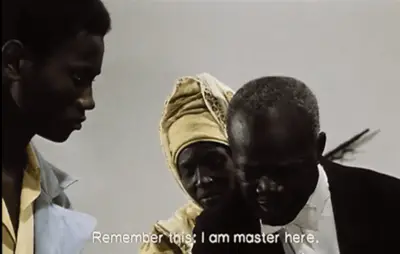
It is at home where El Hadji is most powerful, and most confidently asserts his authoritative image of himself. Shortly after the meeting, El Hadji goes to one of his homes, where Rama accosts him for his polygamy. Hadji hits her and projects this authority: “Remember this: I am master here,” he says. “If you don’t like it, take your revolution elsewhere. It’s people like me, your father, who kicked out the colonizers and freed the country. Polygamy is part of your religious patrimony.”
Here El Hadji asserts both his authority over Rama and his belief of where his authority derives from. Authority legitimized through resistance is a common thread across Sembène and a lot of anti-colonial cinema, and here we see its limitations. El Hadji and his “honorable colleagues” have kicked out the colonizers on paper, but they still submit to them and rely on them for everything. If anything, they aspire to the exact conditions of their colonizers. It’s here that Hadji lays bare his belief that his power derives from him alone and not the systems from which he benefits.
This section of the film also introduces El Hadji’s wives, each of whom represent the different contexts and systems that hang over El Hadji. His first wife, Adja (Seune Samb), is around El Hadji’s age, and carries the duty of the traditional Muslim marriage. She is docile and obedient for the most part, although it is clear that she has her own misgivings with her husband. The defiant Rama is her daughter with Hadji.
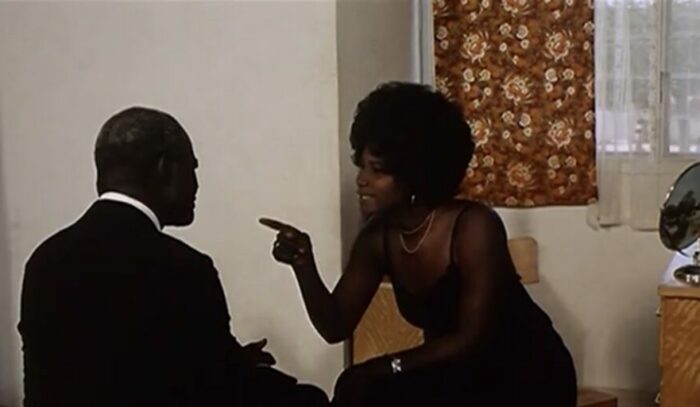
Hadji’s second wife, Oumi (Younouss Seye), is a younger, perhaps more “Western” woman who wears earrings & more revealing clothes. She is not afraid of her husband, sternly telling him off. He is in a way more subservient to Oumi, just as he is subservient to Western neo-colonialism. This might be misinterpreted in a misogynist way with the West symbolized through the trope of the “nagging wife,” but that is antithetical to Sembène’s firm feminism. It’s better worth understanding the character of Oumi more as someone who is not afraid of el Hadji, and does not see it as her fundamental duty to obey him. She is more than just a stand-in for western cultural influence. She is brave; she thinks critically. And she understands that El Hadji is a fragile man.
Hadji’s third wife Ngoné (Dyella Touré) is, meanwhile, hardly a character at all. She is a character who, unlike El Hadji, is under no illusions about how limited she is by the social order. There are few shots where her actual face is shown, and she hardly speaks throughout the film. More often, she speaks through her aunt who accompanies her nearly everywhere. It’s in this way that Xala shows what Ngoné really is for Hadji–a trophy, or a symbol of his success. He sees it as a signal of his own growing power and wealth that he can take on another marriage, and this appears to be more important to Hadji than who he actually marries. She is a tragic character in that sense—her lack of actual dialogue is a reminder of her lost autonomy.
Just as El Hadji seems to be at the peak of his power with his new marriage, he is struck with the Xala, the curse of impotence. With his impotence, Hadji is immediately thrown off. He is certainly not used to anything that might challenge him.
The world of the neo-colonial status quo is a key component of Xala as it emerges to be this challenge for El Hadji. It’s after the night of his marriage that he visits his office, where the inescapable Cora music emerges. The Cora music acts as a subtle reminder of the “Africanity” from which Hadji selectively takes, only when it benefits him. The juxtaposition of El Hadji’s excess, shown in his car, his fancy suit, and the way his employees address him, against the Cora music and the abject poverty in the streets of Dakar just beyond his office, give a perfect sense of the world he perpetuates.
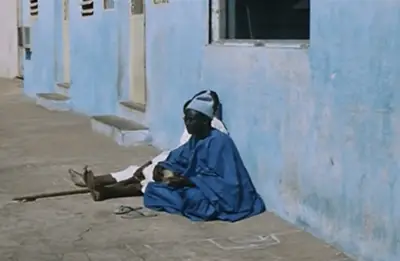
The way Hadji conducts business is another reminder of the neo-colonial hold on Senegal. He deals in—what else—imports. And later in the film, the viewer learns exactly how he got the money to take on a third wife when Hadji reveals that he illegally sold one hundred tons of rice that was meant for distribution by the national food suppliers. Hadji’s curse marks the beginning of his downfall, as his actions turn out to have consequences. His fate is further cemented after he writes a bad check; god forbid! But as more and more people catch on to him, asking after the missing rice, the neo-colonial systems which he legitimizes and benefits from turn on him, and his life comes crashing down.
El Hadji’s true role in this society is perhaps best shown during another meeting of the Chamber of Commerce. In stark contrast to the opening scene, in this meeting the Chamber is openly disdainful of El Hadji for his embezzlement. When he rises to defend himself, he begins to point out that all of his bad deeds are standard practice for people of his ilk; they all write bad checks, they all steal from the needy to fill their own pockets. The only difference between him and them, it seems, is El Hadji’s desperation and sloppiness in his quest to cure his impotence.
None of this is good enough for the chamber, which swiftly votes to expel him. They then immediately bring in a replacement. So from this moment, not only has Hadji been completely shut out of power, but as his swift disposal and replacement shows, he never had any real power to begin with.
The ultimate source of El Hadji’s curse proves to be far more significant than it might seem at the beginning—and it reveals something important about Hadji himself. After his expulsion, and the seizure of his assets by the authorities, El Hadji has nothing left to lose. He is unable to see Ngoné. Oumi leaves him. Adja and her two children, including Rama, stick with him, and ultimately bear witness to his grand humiliation. This comes when the real source of Hadji’s curse reveals itself. It is in fact one of the many downtrodden, disabled, and poor people that the film cuts to intermittently over its run time. Seemingly powerless at first glance, they reveal themselves to be the orchestrator of the entire scheme that brings down El Hadji.
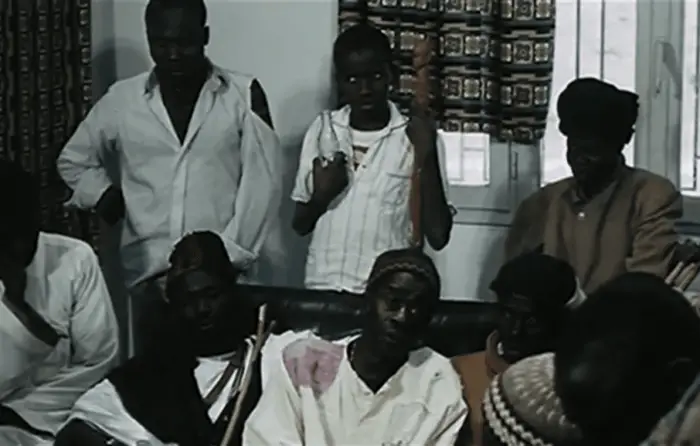
“I am of the Beye family. Now I’ll get my revenge,” says the originator of the curse. According to him, El Hadji falsified his name, robbed him of his inheritance, and had him thrown in jail. The Xala was his stab at revenge. And now that El Hadji has nothing left to lose, Beye proposes that El Hadji strip naked and stand before Beye’s crowd of the downtrodden, who will spit on him to cure his curse. Xala ends with Hadji submitting; This is his rock bottom.
The colonized elite only pretends, or aspires, to power; in reality, its perceived power derives from its ties to the colonizers. Similarly, Hadji thinks his power—over his wives, his children, his business, and so forth—come from him alone, but they are really products of the systems from which he benefits. Xala shows that no one in the colonized elite is intrinsically powerful—they are all impotent, cursed. Sembène’s story pulls a clever trick, too, by having Hadji’s curse derive from someone seemingly below him. His physical impotence is a reminder of his own economic, social, and political impotence, put upon him by those who really understand the condition of his class, and what “Africanity” really means.
Xala is wonderful, easily ranking among Sembène’s best, although it has no shortage of competition. It is very difficult to find today, which is all the more reason to keep discussing and appreciating it—and perhaps to give it a respectful and careful restoration.



